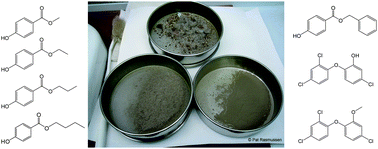An integrated analytical method for the simultaneous determination of five parabens (methyl-, ethyl-, propyl-, butyl-, and benzyl-), triclosan, and methyl triclosan in indoor house dust was developed based on gas chromatographic-mass spectrometric technique (GC/MS). Analytes were extracted from dust samples by sonication. After sample cleanup by solid-phase extraction (SPE), the extracts were derivatized with N-methyl-N-(trimethylsilyl)trifluoroacetamide (MSTFA) and then analyzed by gas chromatography coupled with ion trap mass spectrometry operated in multiple reaction monitoring (MRM) mode. For quantitation, isotope-labelled internal standards were used for each corresponding target analyte. Only 0.05 g of dust sample was needed for the analysis. Method detection limits ranged from 6.5 to 10 ng/g, and absolute recoveries from 74% to 92%. The developed method demonstrated good repeatability and reproducibility, with relative standard deviations (RSDs) less than 16% for all the analytes. The analytes were determined in dust samples collected using two vacuum sampling methods from 63 Canadian homes: a sample of fresh or “active” dust (FD) collected using a Pullman-Holt vacuum sampler, and a composite sample taken from the household vacuum cleaner (HD). Methyl paraben, propyl paraben, and triclosan were detected in all HD and FD samples. HD samples yielded median values for methyl paraben, propyl paraben, and triclosan of 1080, 463, and 378 ng/g, respectively, which were comparable to the FD sample medians of 1120, 618 and 571 ng/g. Ethyl paraben was detected at frequencies of 89% in FD and 73% in HD samples, with median values of 52 and 25 ng/g, respectively. Butyl paraben was detected at frequencies of 44% in FD and 75% in HD samples, with median values of <10 and 59 ng/g, respectively. Benzyl paraben and methyl triclosan were not detected in any of the samples collected by either method. Samples collected according to the fresh dust protocol agreed with the household vacuum samples 90% of the time. Widely scattered concentration levels were observed for target analytes from this preliminary set of 63 Canadian samples, which suggests a wide variability in Canadian household exposures to these chemicals.


 Please wait while we load your content...
Please wait while we load your content...